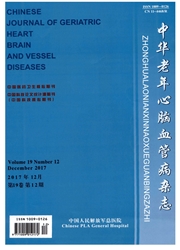

 中文摘要:
中文摘要:
目的探讨黄芩苷对新西兰大白兔颈动脉粥样硬化(AS)的影响及潜在的分子机制。方法健康雄性新西兰大白兔30只,随机分为5组:空白对照组(NC组)、安慰剂对照组(PC组)、阿托伐他汀治疗组(AT组)、黄芩苷预防组(BP组)和黄芩苷治疗组(BT组),每组6只。后4组均在高脂饮食后,进行右侧颈动脉球囊拉伤,构建AS模型。在第2周末和第10周末测定各组血脂水平。第10周末处死大白兔,采用实时荧光定量PCR及Western blot检测各组5-脂氧合酶(5-LO)、5-脂氧合酶活化蛋白(FLAP)和白三烯B4受体(BLTR)基因及蛋白水平表达变化,HE染色测量颈动脉内膜变化情况。结果与NC组比较,PC组TC、TG、LDL-C、5-LO、FLAP和BLTR mRNA及蛋白表达明显增高(P〈0.05)。AT组、BP组和BT组较PC组TC、TG、LDL-C水平、内膜与中膜厚度比值(1.76±0.97,1.04±0.11,1.83±0.17 vs 2.54±0.18)及5-LO、FLAP和BLTR mRNA及蛋白水平明显降低(P〈0.05)。结论黄芩苷可以通过调脂、抑制5-LO炎症途径,发挥抗AS的作用。
 英文摘要:
英文摘要:
Objective To study the effect of Baicalin on carotid atherosclerosis(AS)after balloon injury and its mechanism.Methods Thirty healthy male New Zealand white rabbits were randomly divided into negative control(NC)group,placebo control(PC)group,atorvastatin treatment(AT)group,baicalin prevention(BP)group and baicalin treatment(BT)group(6in each group).The animals in PC,AT,BP and BT groups underwent right carotid balloon angioplasty and a carotid AS model was established after they were fed with high-fat diet for 4weeks.Their blood lipid levels were measured at the end of 2and 10 weeks,respectively.The animals were sacrifised at the end of 10 weeks and expressions of 5-lipoxygenase(5-LO),5-lipoxygenase activating protein(5-LAP)and leukotriene receptor(LTBR)were detected by RT-PCR and Western blot,respectively.The carotid tunica intima was measured with HE staining.Results The blood lipid level,ratio of carotid tunica intima/tunica tunica,and expression levels of 5-LO,5-LAP and LTBR mRNA and proteins were significantly higher in PC group than in NC group(P〈0.05)and significantly lower in AT,BP and BT groups than in PC group(1.76±0.97 vs 2.54±0.18,1.04±0.11 vs 2.54±0.18,1.83±0.17 vs 2.54±0.18,P〈0.05).Conclusion Baicalin can inhibit carotid AS by regulating the blood lipid level and suppressing the 5-LO pathway.
 同期刊论文项目
同期刊论文项目
 同项目期刊论文
同项目期刊论文
 Human Albumin Improves Long-Term Behavioral Sequelae After Subarachnoid Hemorrhage Through Neurovasc
Human Albumin Improves Long-Term Behavioral Sequelae After Subarachnoid Hemorrhage Through Neurovasc 期刊信息
期刊信息
